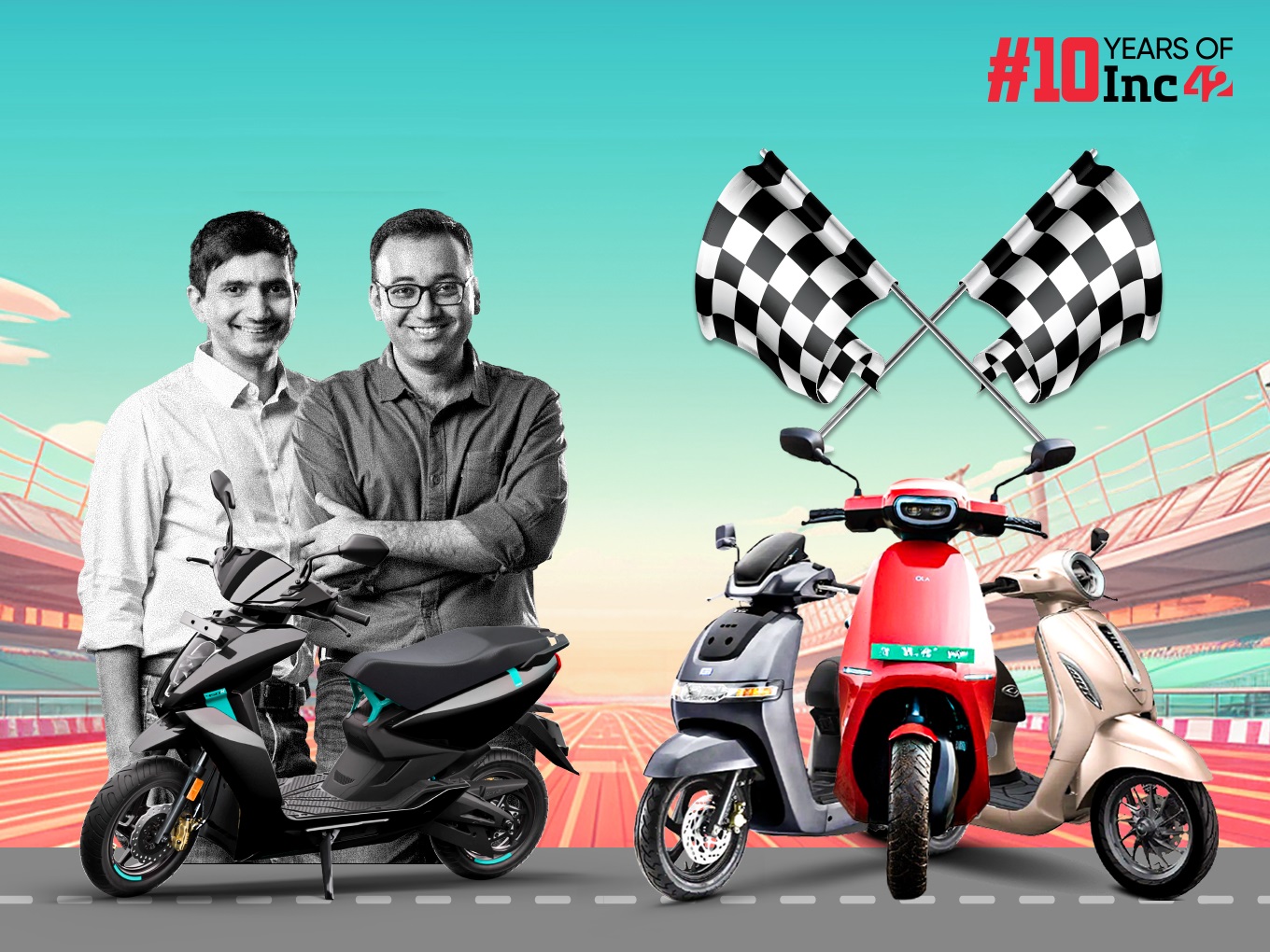SUMMARY
Despite Ather Energy's early entry and technological prowess, its market share has not improved for the past five years, raising questions about its strategic choices and ability to compete with industry leaders
The company remains undervalued when compared to the peers, believes many including Ather cofounder Tarun Mehta
Despite no growth in market share in mid run, Ather is at excellent position to acquire much more market share in the long run, given it fixes a few things, experts dive in
India’s electric vehicle market has changed drastically in the past three years, but for Ather Energy, a pioneer of sorts in the EV startup ecosystem, it’s been a story of stagnation.
Electric two-wheelers (E2W) today command a significant 60% market share of all EVs with the likes of Ola Electric, TVS, Chetak and Hero MotorCorp’s Vida joining in the past three years to compete with Ather.
While Ather Energy looked to distinguish itself on the back of its design and technological prowess as well as a patient approach to product development and ecosystem surrounding the product, the competition has swerved.
If Ola Electric has set the pace, then the likes of TVS and Bajaj have also ramped up their EV verticals, even as Ather Energy is still busy establishing the infrastructure it needs to scale up. Now Ola Electric is on the IPO track and Ather is on the drawing board for its next generation of products.
As Ather’s first mover advantage seems to be vanishing, can the company bounce back thanks to its strategic partnership with Hero Motocorp or will the Bengaluru-based EV startup falter in the face of the growing competition?
Ather Energy’s Lead Slips
Having successfully set up two manufacturing plants in Tamil Nadu with a combined capacity to produce 4.2 Lakh scooters annually, Ather is bullish about the future.
Additionally, Ather Energy has a network of 1,700+ fast charging stations across the country which offer it the infrastructure advantage. The company plans to take these numbers to 5000+ by the end of this calender year.
However, it’s the emergence of deep-pocketed players like Ola Electric, TVS and Bajaj in the E2W segment that Ather Energy is struggling to catch up. While IPO-bound Ola Electric’s market share has grown from 21% in April 2023 to 33% currently, Ather’s market share has remained stagnant at 11% during this time.
In all fairness, Ather now has 11% of a larger market, but given its first-mover advantage, perhaps many are asking if it should have pushed for faster growth, especially because Ola was clearly stepping on the accelerator.
Legacy two-wheeler players TVS and Bajaj have also significantly increased their market share — with the former now accounting for 20% of the market, and Bajaj grabbing 10% market share.
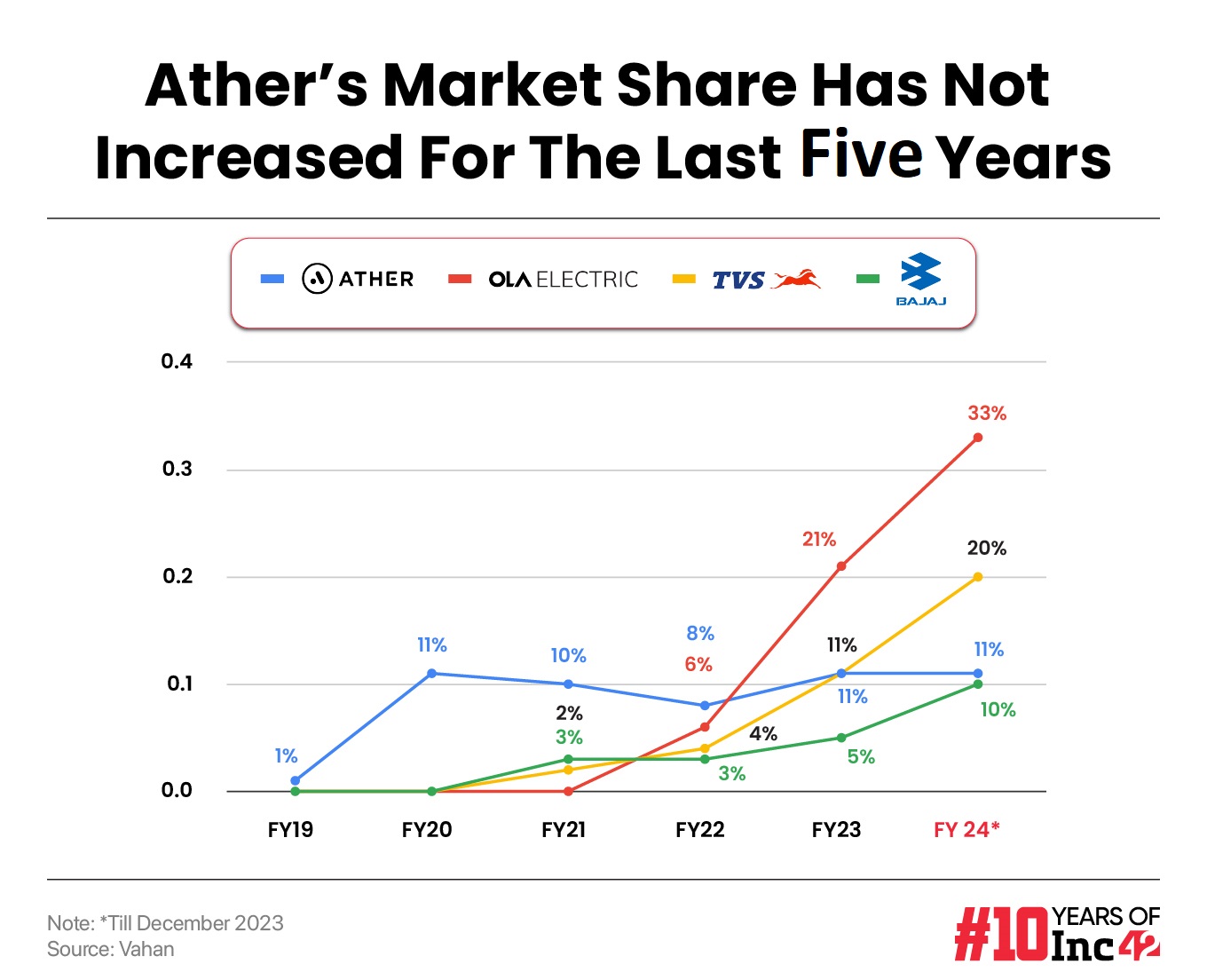
So, when all the key players are flourishing in this burgeoning space, what is holding Ather Energy back?
It’s the revised FAME II initiatives that led to this market dynamics, says an Ather official.
An Ather spokesperson said, “With the FAME II revision that happened earlier this fiscal year, we slowed down our network expansion and product portfolio expansion due to the uncertainty in the industry. Currently, we are steadfast in our growth journey and are working on expanding our product portfolio and retail network after successfully navigating the difficult headwinds that the EV industry faced post-FAME II policy revision. We have started to add more retail outlets and will soon launch our first family scooter.
Having said that, we have recovered most of our pre-subsidy revision market share. If you look at the data from the last 3 months, our market share is around 13.1%, and we are confident of crossing our highest market share soon.”
Here, it must be noted that Ather Energy was so early to the space that it had to focus on the fundamentals rather than the breakneck growth that Ola has shown. At a time when the Indian market was flooded with Chinese assembled and imported E2Ws, Ather played a key role in changing the people’s perception towards the quality and making it available locally.
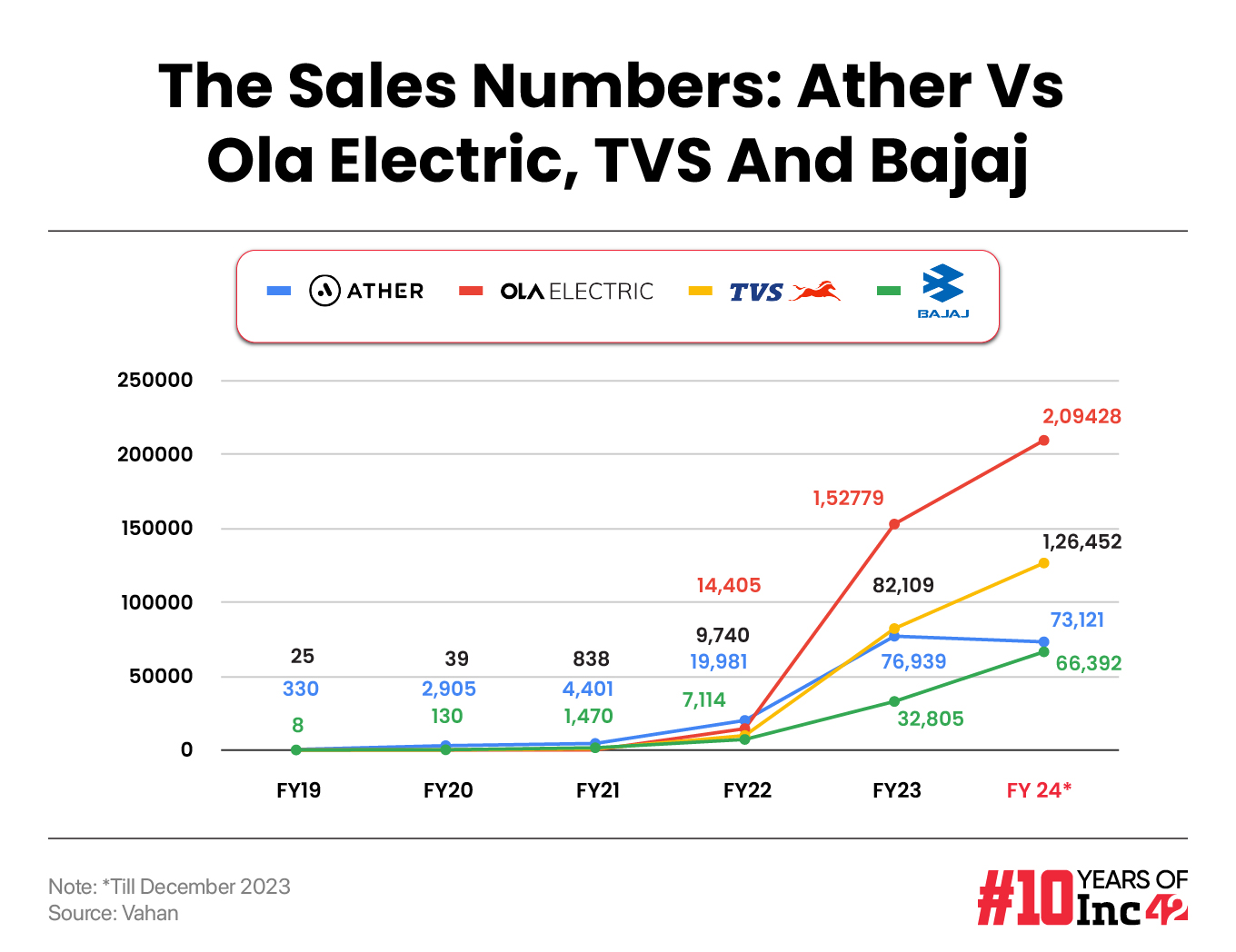
A source involved in the company’s day-to-day affairs told Inc42, “Initially, the company didn’t have the adequate infrastructure to cash in on its first-mover advantage. It took much effort and time to build a small assembling unit in Whitefield, Bengaluru, which later had a maximum capacity of producing 20K-30K scooters a year.”
At the outset, the company was only producing 75 scooters a month but this was later increased to 2K+ scooters per month. Despite this, the EV maker was unable to meet the demand in the early days which might have changed the current situation, we were told.
The waiting period for customers was over six months at times. Back in 2018-2019, the demand was such that the company is said to have halted bookings multiple times.
When it had sorted out some of these production challenges, the shortage of semiconductor chips added to the slow scaling up between 2019 and 2022. And when it was out of the chip crunch, Ola entered the picture to change the competitive dynamics.
With Ola Electric on its radar, the company is aiming to set up one more manufacturing plant to take its capacity up to 1 Mn scooters annually or more than 2X higher. A third plant was planned to be functional by FY 24. However, the startup has not even finalised the location yet.
The company is in discussions with various state governments, said the company spokesperson.
Despite the headway that it had after launching in 2013, Ather Energy’s potential scale is dwarfed by Ola Electric. While the current capacity of Ola Electric Futurefactory at Krishnanagar is believed to be 1 – 2 Mn E2W per year, the unit is said to be expandable up to 10 Mn — which Ola calls the largest such facility in the world.
Ather Energy has to significantly scale up its production capacity to catch up with the pace that Ola Electric is looking to set.
Ather Energy was one of the first companies to build the aspiration for EVs among Indians, said Dr Allabaksh Naikodi, former head of EV, Royal Enfield, and former CTO of JLN Phoenix Energy.
Ather developed a great product with great design and better quality, but Ola Electric has pulled ahead because of the supply chain, digital sales strategies, big bang marketing, and other factors, including funding, he said.
Anyone buying an electric scooter looks for affordable pricing, range capacity, power, and speed. While Ather Energy offers a good range of up to 150 Km (certified), Ola Electric claims to surpass some of the key metrics by significant margins. This is where the tall claims of Ola Electric attract the consumers more and hence their sales numbers.
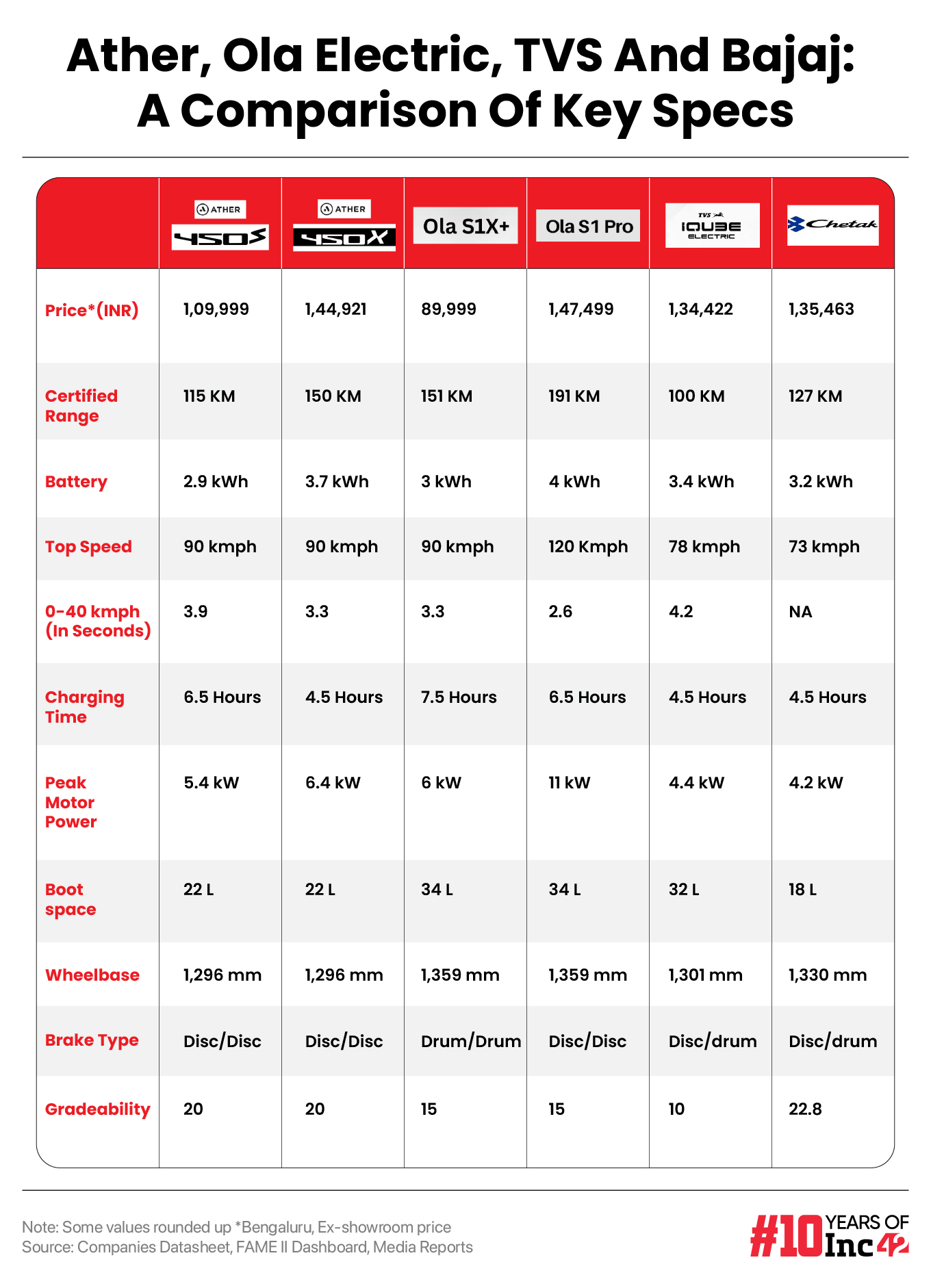 ather-energy
ather-energy
Besides, Ola Electric, TVS, and Hero MotorCorp already have a strong product line for future launches. This includes Escooters, e-bikes, cars (by Ola Electric), and electric three-wheelers. Ather Energy has unveiled one family scooter Ather Rizta so far. While Ather intends to launch e-bikes as well, there is no clarity over the product launches.
EV Pioneer Looking To Fuel Up
One could say that Bhavish Aggarwal’s previous business experience of building and scaling up Ola gave investors more confidence about Ola Electric’s chances in the market. And while Aggarwal’s original plan for Ola Electric was an electric mobility business, it morphed into an EV maker rapidly when there was an opening in the market.
Unlike Aggarwal, Ather cofounders Tarun Mehta and Swapnil Jain were first-time entrepreneurs. The company first started with building a battery pack and a battery management system before venturing into its current OEM model.
As a result, funding for Ather Energy came in fragments. Unlike Ola Electric, it didn’t have enough funding in the early days to set up a large manufacturing plant. It chose to start off manufacturing in Whitefield, Bengaluru, before moving to Hosur in Tamil Nadu.
Today, Ather Energy has raised over $400 Mn in debt and equity funding through a dozen rounds. But is this enough to compete as an OEM?
According to industry experts, the total capital raised may be adequate to keep Ather Energy going in the short to medium term, but it may not be enough to take on Ola Electric, TVS and Bajaj.
While Ola Electric was founded much later, almost five years after Ather Energy, it has raised over $1.5 Bn to date and has been able to disrupt the entire EV market. After two-wheelers, the company is planning to launch electric cars by 2025, while Ather is still stuck with a limited SKU volume.
The other rivals are also bulking up — TVS claims to have injected over INR 1,000 Cr into the E2W biz, and Bajaj is said to have injected over INR 750 Cr.
Only a small fraction of their resource base is dedicated to EVs, yet they have been able to double their market share in the last two years.
They can threaten the leadership position of Ola Electric in a few years as they ramp up investments, believe experts. So what option does Ather have?
Hemanth Kumar, cofounder of Bullwork Mobility who earlier worked with both the companies Ola Electric and Ather Energy added that funding plays a critical role for any OEM’s survival.
Seconding him, Dr Deb Mukherji, MD of Anglian Omega Group which owns EV OEM Omega Seiki Mobility said, “The funding gap has been solved by joining hands with Hero MotoCorp. In the automobile space, it’s always about the partnerships and collaborations which can fill the funding gap.”
Largest investor in the Ather Energy, Hero MotoCorp and Ather Energy’s partnership extends to building an interoperable fast-charging network, which improves the unit economics of Ather’s infrastructure business and allows it to focus more specifically on being an OEM.
The collaboration with Hero enables EV users of both companies to be able to locate and navigate to the charging stations through the My VIDA and Ather’s apps.
Mukherji added that Hero MotoCorp will be a key strategic partner for Ather Energy which can solve scaling-up problems. “Whether it’s the expansion plans or logistics/supply chain-related issues, Ather Energy won’t have to worry about anything,” he added.
Funding is not going to be an issue. An Ather spokesperson however asserted that the company has raised around $400 Mn till now, which is the second highest funding any E2W company has raised globally to date. “In the last 18 months, our shareholders have invested cumulatively INR 1300 Cr in Ather. We have a strong list of shareholders who have been a part of Ather for a while, and have been strong backers,” the spokesperson said.
How Can Ather Turn It Around?
What Ather does best is offering the best ride experience in conjugation with customer service experience, qualities that take their time to reach the critical mass in the market, according to Bullwork’s Kumar.
Despite being a smaller company, he believes that Ather offers a much better customer service experience, which consumers will eventually reward.
This could also be understood by the fact that on the Consumer Complaints Forum, the decade-old Ather Energy has only two complaints, while Ola Electric has over 166 complaints in two years. Of course, the counter-argument is that Ola Electric has sold twice the number of scooters in that time frame, but this does not justify the skewed ratio of complaints.
However, Naikodi believes that Ather’s leadership role in customers’ perspective is slipping too. The company needs to revive how it used to connect with customers on a personal basis.
Another aspect where many consider Ather Energy to have some lead over Ola Electric is the value engineering. An EV analyst pointed to wheelbase/kerb weight differences of Ola S1 Air and Ather 450S, where Ola Electric’s scooter weighs less than Ather despite having a much larger wheelbase and a slightly bigger battery. “Ola’s S1 Air is almost 9 Kg lighter than the Ather 450S. Where do you think they have reduced the weight to achieve this?”
The fire incident involving Ola S1 Pro scooters in Pune last year led to Ola Electric paying a fine of INR 15 Lakh. Whether the company is likely to face a similar fine in the future is uncertain, but there have been other reports of safety incidents since last year, which may still be investigated.
The company has allocated INR 68 Cr for warranty expenses as of June 30, 2023, increasing from INR 44 Cr and INR 12 Cr as of March 2023 and March 2022, respectively. Ola Electric is yet to complete a full warranty cycle since the policy covers three years, and the company says it has only seen a limited number of claims for the scooters it has sold.
Maintaining that building the highest quality scooter is the Ather USP, a spokesperson added, “Quality over on-paper specs – Ather has demonstrated that an Indian company can build some of the highest quality standards in the 2W industry, all locally built and homegrown. No JVs to get ‘access’ to tech and no acquisitions. Customers buy an Ather product for its peace of mind, experience and quality. We remained obsessively focused on the same.”
The Cost Of Being An OEM
Ather Energy’s expenditure on the cost of materials consumed is over 90% of the operating revenue. Dr Mukherji believes that the company is making a significant loss on each vehicle it sells, just like other leading OEMs currently.
Secondly, gaining a better control over EV cells supply and pricing is believed to be crucial for EV OEMs. BYD, primarily a cell manufacturing company, is currently touted to be the biggest EV car manufacturer in the world, surpassing Tesla by significant margins. In Q4, 2023, BYD sold a record 526,000 battery-only vehicles while Tesla delivered 484,500 electric vehicles.
Some of the key EV manufacturers such as Tata Electric Mobility and Ola Electric have also entered the cell manufacturing business. For instance, Tata has committed INR 13,000 Cr to build a Gigafactory in Gujarat. Ola Electric raised an initial investment of INR 3,200 Cr to build its 100 GWh Gigafactory.
Log9 Materials has built a 25 MWh capacity plant at INR 190 Cr and plans to build a 25 GWh gigafactory at an estimated cost of INR 10,000 Cr.
Ather Energy, on the other hand, has invested INR 320 Cr in its Hosur second plant which includes both a battery manufacturing plant with 1.2L battery packs capacity and EV manufacturing plant. It has planned to invest INR 650 Cr by 2027.
Whether it’s building a cell manufacturing plant or designing and manufacturing new products such as electric bikes, which TVS and Ola Electric have already showcased, would need a long-term investment. While Ather has raised over INR 1300 Cr in 2023, can it meet the short-term and long-term requirements?
Sources say, the fundraising process for Ather has been a roller-coaster ride in the past. Barring Hero MotorCorp,some of the key investors such as Tiger Global have not made follow-on investments despite multiple talks. It took Ather seven years to raise another institutional funding in 2022 since it first raised from Tiger Global in 2015.
In 2023, besides having raised $108 Mn from GIC and Hero MotorCorp, the company secured another INR 140 Cr from existing investor Hero MotoCorp from rights issue.
Undervaluation of the company has been a challenge behind the high equity dilution at the lower amount.
Ola Electric is going for an IPO at close to a $7 Bn valuation, while Ather Energy is reported to be privately valued at $800 Mn.
Back in 2021 and 2022, Ather Energy cofounder Mehta publicly admitted the fact that his company is undervalued. In response to the difference between the Ola Electric valuation and that of Ather’s, Mehta said, “Ather is considerably undervalued still… In a way, I take responsibility for that.”
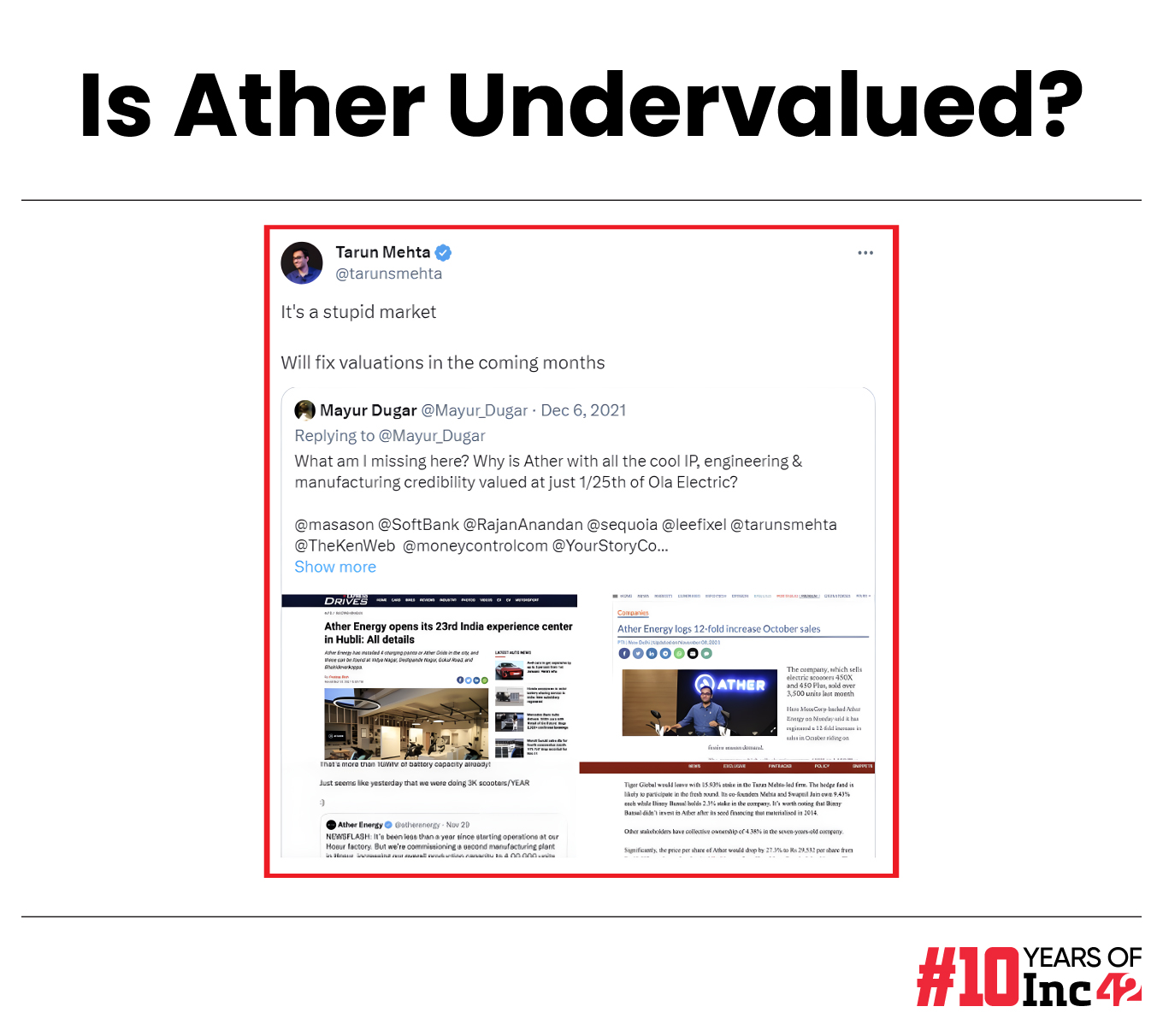
But the aforementioned capital infusion has not boosted the valuation significantly, and resulted in equity dilution. Founders are currently the minority stakeholders at 9.96%, with Hero MotoCorp alone owning 39.7% and the remaining shares being held by various funds and angel investors.
“This has pushed the founders into a corner where they would have limited options to raise institutional funding. In the long run, this could also impact their ability to make decisions in the boardroom as well,” said an EV analyst.
Ather spokesperson however believes that there is unnecessary focus being given to the valuation debate. “The media needs to reassess its overemphasis on valuations. It’s not healthy, as we have seen in multiple cases before. At Ather, we will continue focusing on building a capital-efficient and sustainable business,” said the spokesperson.
Those who have worked with the founders of both Ola Electric and Ather Energy believe that culturally, the leadership of the latter is very different. “If you meet Bhavish Aggarwal and then the Ather cofounders, you will find a huge difference. Aggarwal’s focus is on building massive businesses. On the other hand, Ather’s cofounders have always been focussed on building a better product,” says Bullwork’s Kumar.
Path To Profitability
These two approaches have their pros and cons, but the E2W market is changing rapidly and Ather has been moving too slowly.
Mukherji believes Ather has to figure out a mass product, which can compete with the 110 cc and 125 scooters directly.
He cited the example of how Suzuki turned things around. It hardly owned 8% of the market share for SUVs, but it wanted to capture 50% of the market share eventually. Starting with ‘Brezza’, Suzuki today owns more than 22% market share. It’s planning more products to get to 50% market share. Ather needs a similar kind of approach, Mukherji said, where its product strategy has to align with market factors.
This has been the core focus of Ather for some time now. It needs to turn profitable soon. But how does it intend to come in the black in the main question?
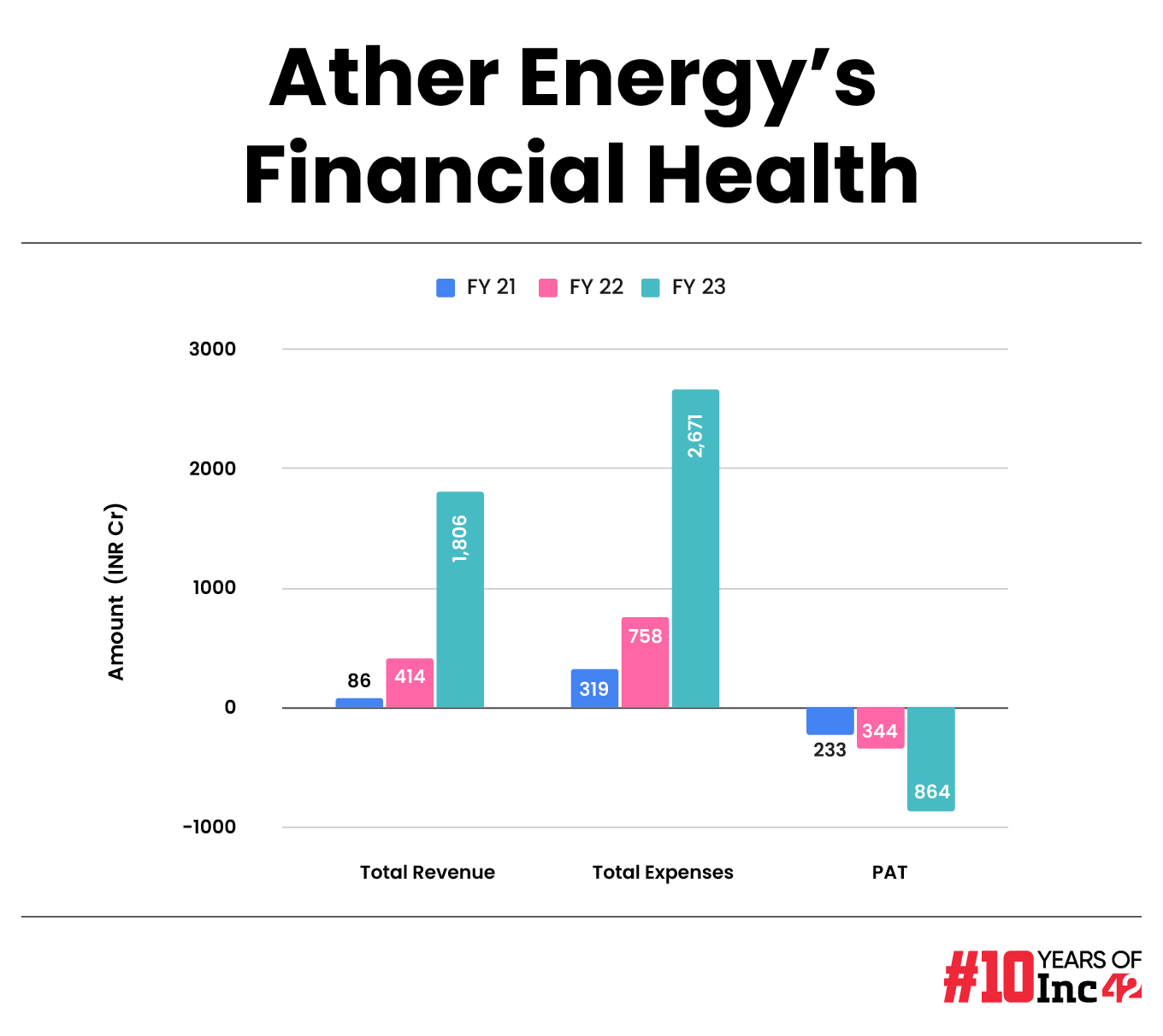
Naikodi believes Ather has to solve the procurement costs, “Buying cells, which one has to import, is a costly affair. If you buy over a million cells at a time, it’s almost 20-25% cheaper. This could be a big factor in profitability, but for that Ather has to increase manufacturing.”
And, not just cells, over 300 components are currently imported for building an E2W in India.
This is also one of the areas where Ola Electric may have an edge over Ather Energy. Mukherjee believes this could be compensated by better value engineering and Hero MotoCorp as a partner.
Just as Kia and Hyundai source components together at a cheaper rate, Hero MotoCorp and Ather could join hands or form a JV for joint procurement. The companies could also look at building a cell manufacturing plant under the government’s PLI scheme to lower their collective costs and improve the product life cycle.
Localisation could be the key behind the cost minimisation, believes Ather. “Ather has one of the, if not the highest levels of localisation with our motors, controllers, VCUs, battery packs, BMS, frames, suspensions all built right here in India. There’s a great component ecosystem in India and it would be incorrect to believe otherwise,” said the spokesperson.
Ather Needs To Be More Agile
When Ola launched its product, the EV maker tried to do everything at once. The approach was to sell first using the Ola Cabs platform, followed by building the showrooms, service centres and charging stations.
The company first built one of the largest factories — Futurefactory — followed by Gigafactory, charging stations and unveiled new products including e-bikes and electric cars.
Ather’s approach has been more planned. The approach has been building the user-centric infrastructure such as charging stations and service centres first, before launching the E2W in the particular market.
However, this strategy will not help Ather today, according to some EV market analysts.
In a fast-evolving market, Ather Energy needs to be more agile in new product launches. Instead of building everything, it also needs to let go of a few products that could be available at cheaper prices, experts said.
Lastly, unlike Ola which has been selling the specs, Ather has been trying to build a better product experience, However, this is hardly visible in their branding and advertisements said the likes of Mukherji.
As the EV market continues to evolve and mature, Ather Energy’s ability to adapt and innovate will be crucial in determining its future. Can the OG electric vehicle startup in India fight off Aggarwal’s Ola Electric juggernaut and legacy players?
[Edited by Nikhil Subramaniam]



